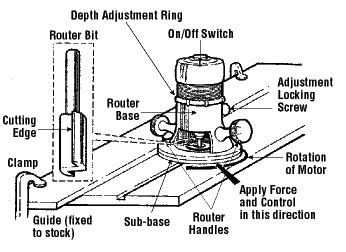Powered Hand Tools - Routers
On this page
What should you do before starting to cut with a router?
Back to top- Wear safety glasses or goggles, or a face shield (with safety glasses or goggles), appropriate hearing protection, and respiratory protection, if required.
- Disconnect the power supply before making any adjustments or changing bits. Inspect bits carefully before installing.
- Ensure that the bit is securely mounted in the chuck and the base is tight.
- Put the base of the router on the work, template, or guide. Make sure that the bit can rotate freely before switching on the motor.
- Secure the stock. Never rely on yourself or a second person to support or hold the material. Sudden torque or kickback from the router can cause damage and injury.
- Check the stock thoroughly for staples, nails, screws, or other foreign objects.
- Check the router's speed settings when working with variable-speed routers.
- Keep all cords clear of the cutting area.
- Make sure the work area is clean, well-lit, and free of obstructions.
- Secure the workpiece to prevent movement during operation.
- If using a battery-powered router:
- Inspect the battery for any damage, cracks, or leaks before use.
- Follow the manufacturer's instructions for charging and storing the battery. Avoid overcharging or exposing it to extreme temperatures. See the OSH Answers on
Battery Charging - Lithium-ion Batteries for more information.
What should you do to work with a router safely?
Back to top- Always hold both hands on the router handles until the motor stops. Do not set the router down until the bit stops turning.
- Do not overreach. Keep proper footing and balance.
- Avoid working in wet or slippery conditions.
- Make sure there is proper ventilation when working indoors.
- When inside routing, start the motor with the bit above the stock. After the router reaches full speed, lower the bit to the required depth.
- When routing outside edges, guide the router counterclockwise around the work.
- When routing bevels, mouldings, and other edge work, make sure the router bit is in contact with the stock to the left of a starting point and is pointed in the correct cutting direction.

- Feed the router bit into the material at a firm, controlled speed.
- With softwood, you can sometimes move the router as fast as it can go.
- Cutting may be very slow with hardwood, knotty and twisted wood, or with larger bits.
- Listen to the motor sound to determine safe speeds:
- High-pitched whine: The router is moving too slowly.
- Low growling noise: The router is being pushed too hard.
- When the type of wood or size of the bit requires going slow, make two or more passes to prevent the router from burning out or kicking back.
- To decide the depth of cut and how many passes to make, test the router on scrap lumber similar to the work.
If a router is connected to a router table, refer to Woodworking Machines - Shapers for more guidance.
Refer to Powered Hand Tools - Electric Tools - Basic Safety for general electrical safety tips.
- Fact sheet last revised: 2025-08-25

